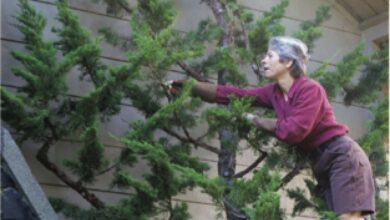Every Week is Eat Local Week at Larks
Damon Jones has been the executive chef for Larks Home Kitchen Cuisine in Ashland since 2005. Since 2013, when Larks opened a second location in Medford, he divides his time between the two restaurants, managing two culinary teams. In support of Thrive’s Eat Local Week, Damon talks with us about the commitment to local food, from a restaurant’s perspective.
Could you tell us about the inspiration behind the name “Larks Home Kitchen Cuisine?” What’s the intention behind the cooking at Larks?
When the Neumans hired me, Becky had this idea of farm-to-table, so “Home Kitchen Cuisine” was really about simple, clean food from scratch that evokes memories of what your grandmother would have made. It’s not a new concept – restaurants have been doing it for hundreds of years before giant middlemen showed up. There’s recently been a rejuvenation of that thought process though, and I just feel fortunate to have been given the opportunity by the Neumans to source the best ingredients possible, to establish relationships with these farms, and to put together a restaurant that focuses on that.
Many restaurants say they cook “from scratch.” What does that mean at Larks?
We make everything [in house] – our stocks, our demis, our ketchups, mustards, mayonnaises. I’m a fundamentalist at heart when it comes to cooking. I want to have control and knowledge of as many aspects of a plate of food as possible. I want to know where the product is from, how it was handled, and how it was cared for.
If you have the best ingredients, you don’t have to worry about camouflaging anything. You can let the ingredients stand on their own. We use sea salt and fresh herbs, and we toast and grind our own peppercorns. That’s pretty much the seasoning we work with. The fewer ingredients you use, the more you can accentuate them. I think that kind of restraint just comes from experience.
It’s easy to see how being in an ongoing conversation with your farmers would be key to sourcing the best, local ingredients possible. Can you tell us about the farms Larks partners with?
We probably buy more produce from Dave over at Dunbar Farms than we do anybody else. We get all our polenta from him, as well as our salad greens and tomatoes. He has a connection with Hillcrest Orchards, so we get a lot of our apples and peaches and pears from those guys.
Most of the farms we work with are families that are working on a couple of acres, and they’re doing this as a sort of a philosophical lifestyle choice … you know, it’s very tough work.
We started two years ago with this guy named Jeff from Wandering Root. He has a great list of diverse products. Another great one is Josh at Barking Moon Farm – we’ve been using him for years and years. There’s Mary from Whistling Duck – that’s probably the second farm I started working with. We use a lot of cheeses from Vern at Pholia Farms. They raise Nigerian Dwarf goats, and make these really amazing cheeses. Rise Up Artisan Bakery in the Applegate makes the rosemary ciabatta we serve when our guests sit down at the table. That’s Jo and Rosie. We do Mushrooms All Year from Louie. There’s Kyle over at Terra Sol, and Paige at One Leaf Microgreens. There are a lot of them; I’m sure I’m skipping some.
We get deliveries directly from farms four or five days a week, both at our Ashland and Medford properties, and we don’t look for just the specialty stuff that they have – we buy onions and carrots and the base ingredients like potatoes. Buying base ingredients builds up the money on the invoice, which in turn makes it more profitable and more worth their while to deliver to us.
Eating local for an individual takes a serious commitment. I’m sure sourcing food locally for a restaurant presents its challenges. Can you break it down for us? What amount of the food served at Larks is sourced locally?
Right now in the summertime, when the farms are at maximum production, we’re probably in the ballpark of 60 – 70% local. Another 25 – 30% of that is from the state of Oregon, and then it ventures out into the Pacific Northwest.
You can’t get everything you need year-round from [local farms.] Those percentages change in the wintertime when the farmers are really only producing winter squash and some storage things like onions; in the winter it probably drops to about 30%.
But we purchase from small-scale farms year round. Within a year, we probably spend between $200,000 and $250,000 with local purveyors (and that number would be even greater if you include all the wines we purchase).
That money is going back into the local economy. If you’re coming in and spending your money with us,
there’s a good chance that a percentage of that money is actually going back to your neighbors.
So how do you build a seasonal menu? What’s that process like?
Our menus maintain the same size, since they’re based off the functionality and size of the kitchen. So
generally we start by taking off the menu what we know is going out of season, and then we build plates by starting with the protein and going from there.
I always call our kitchens “cooperatives” – all our chefs and cooks are generally involved with our menus. Based on what the farms deliver, our chefs and cooks come up with our daily specials.
There’s such a bounty of raw ingredients available here in southern Oregon, and at Larks, we really do honor that rich agricultural heritage in our seasonal menus.
Visit Larks online at www.larksrestaurant.com.





